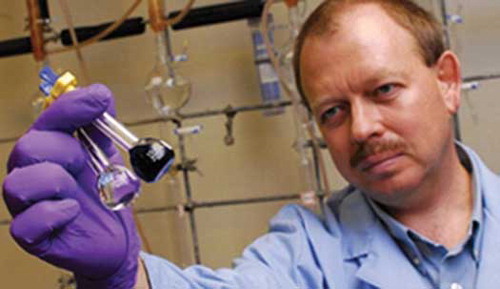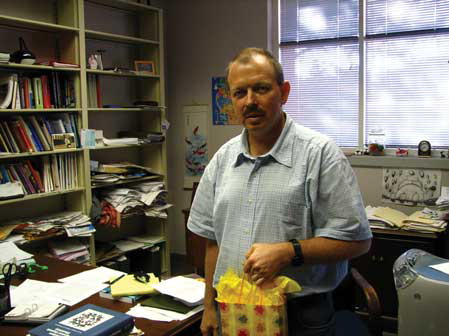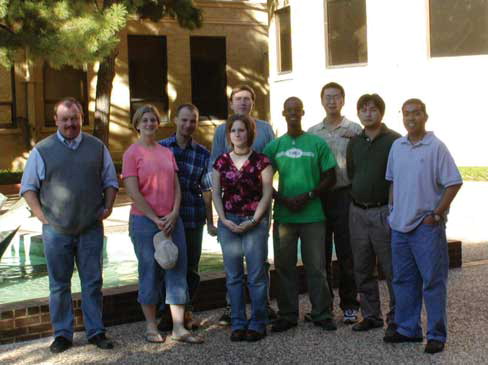Abstract
This publication is dedicated to the memory of Professor Dmitry M. Rudkevich (1963–2007), my great friend and adviser, a person with a big heart, and a brilliant scientist. Professor Dmitry M. Rudkevich was the first who brought me into the amazing world of supramolecular chemistry and molecular recognition.
GRAPHICAL ABSTRACT

September 23, 2014, would have been the fifty-first birthday of an outstanding organic chemist who had a bright scientific future and was a great friend to many—Prof. Dmitry M. Rudkevich. Although Dmitry M. Rudkevich was classically trained as an organic chemist and his first Ph.D. was in organic chemistry, his research was widely multidisciplinary and included many aspects related to inorganic chemistry, such as the synthesis of supramolecular metallo-receptors, sensing of liquid toxic waste components (inorganic anions, transition metal cations, etc.), and recognition and/or supramolecular fixation of hazardous inorganic small molecules (NOx, SOx, and other greenhouse gases).
Figure 1 Dmitry M. Rudkevich in his lab (UT Arlington) demonstrating the chemical fixation of NOx by calix[4]arenes: a colorless solution of pure calix[4]arene instantly turned purple upon a short-time exposure to NO2/N2O4.[Citation52] © The University of Texas at Arlington. Reproduced by permission of The University of Texas at Arlington. Permission to reuse must be obtained from the rightsholder.
![Figure 1 Dmitry M. Rudkevich in his lab (UT Arlington) demonstrating the chemical fixation of NOx by calix[4]arenes: a colorless solution of pure calix[4]arene instantly turned purple upon a short-time exposure to NO2/N2O4.[Citation52] © The University of Texas at Arlington. Reproduced by permission of The University of Texas at Arlington. Permission to reuse must be obtained from the rightsholder.](/cms/asset/d516c6a0-2561-4e73-98c7-5478daf840aa/gcic_a_994062_f0001_oc.jpg)
Born in Ukraine, Rudkevich earned his M.S./B.S. degree in 1985 at the Kharkiv Polytechnic Institute (now National Technical University “Kharkiv Polytechnic Institute,” Kharkiv, Ukraine). After this, he moved to Kiev, where he received his first Ph.D. degree in organic chemistry in 1989 from the Institute of Organic Chemistry of the National Academy of Sciences of Ukraine (Kiev) with Prof. Leonid N. Markovsky (now deceased). In 1992, he joined the research group of Prof. David Reinhoudt at the University of Twente in the Netherlands, where he worked on molecular recognition,[Citation1–Citation3] self-assembly,[Citation4,Citation5] and supramolecular chemistry of calix[4]arenes.[Citation6Citation7Citation8Citation9] In 1995, he received his second Ph.D. in supramolecular chemistry with a Ph.D thesis entitled “Calix[4]arenes in Molecular Recognition.”
In 1996, Rudkevich joined the group of Prof. Julius Rebek, Jr., at Massachusetts Institute of Technology (Boston, MA, USA) and later at The Scripps Research Institute (La Jolla, CA, USA), where he simultaneously carried out several research projects on self-assembled supramolecular hosts: molecular capsules formed and stabilized by non-covalent (hydrogen) bonding,[Citation10Citation11Citation12Citation13] resorcinarenes,[Citation14] resorcinarene-based cavitands (deep cavity[Citation15,Citation16] and “self-folding” cavitands[Citation17Citation18Citation19Citation20Citation21]), and encapsulation processes.[Citation22,Citation23] Here, some new concepts were developed in supramolecular chemistry, such as chemical amplification of organic reactions within molecular capsules[Citation24,Citation25]; a new type of stereoisomerism in a confined cavity of the supramolecular host: due to the spatial relationships between two encapsulated molecules of one guest (toluene or γ-picoline), they became stereoisomers (by the supramolecular nature), but each of these stereoisomers forms and exists only in the presence of a second co-guest[Citation26]; and a very unusual encapsulation of hetero-guest pairs by the molecular capsule, which is possible because of mechanical barriers within this capsule.[Citation27] In 1997, he was promoted to Research Assistant Professor at The Skaggs Institute for Chemical Biology at Scripps.
Figure 2 Rudkevich at UT Arlington in 2004.[Citation53] © Wiley-VCH Verlag GmbH. Reproduced by permission of Wiley-VCH Verlag GmbH. Permission to reuse must be obtained from the rightsholder.
![Figure 2 Rudkevich at UT Arlington in 2004.[Citation53] © Wiley-VCH Verlag GmbH. Reproduced by permission of Wiley-VCH Verlag GmbH. Permission to reuse must be obtained from the rightsholder.](/cms/asset/a6463666-ff26-4ddc-bba4-71fba88a5518/gcic_a_994062_f0002_b.png)
In 2001, Rudkevich joined the faculty of the Chemistry and Biochemistry Department at the University of Texas at Arlington (UTA) as an Assistant Professor, where he started his exciting research in the area of supramolecular chemistry and molecular recognition of gases. He received tenure at UTA in two years and, in 2004, he was promoted to Associate Professor. For high achievements in his career from 2003-07, he was named an Alfred P. Sloan Fellow. As a well-known scientist during that period, he gave numerous lectures on the molecular recognition and supramolecular chemistry of gases at various universities and meetings, both nationwide and worldwide, as an invited speaker.
His research interests varied from classical synthetic organic chemistry, where he began his career, to organic supramolecular chemistry and molecular recognition, self-assembly, nanochemistry, materials and sensors, and chemistry and application of calix- and resorcinearenes. He successfully applied supramolecular chemistry for the molecular recognition of gases, where he was among the pioneers. He was the first to successfully introduce calixarene-based materials, including solid-supported calixarenes[Citation28] and calixarene nanotubes,[Citation29Citation30Citation31Citation32Citation33] for the chemical fixation[Citation34,Citation35] of NO2/N2O4, a major component of NOx gases. These aggressive environmental pollutants were converted into stable nitrosonium complexes, which were utilized further for controlled NO+ release (so-called “encapsulated nitrosation reagents”[Citation36,Citation37]) or direct NO-gas release.[Citation38,Citation39] The hemicarcerand-based supramolecular host introduced by Rudkevich and Dr. Alex Leontiev was able to encapsulate and store “laughing gas,” N2O,[Citation40] both in a solution and in the solid state. Other gases could be simply isolated,[Citation41] including N2 from ambient air and CO2.[Citation40]
Figure 3 Dmitry M. Rudkevich in his office (UT Arlington, 2006), surrounded by chemistry textbooks and new ideas. (Photo by Dr. Hexiang Zhang).

In addition to NOx gases, Rudkevich introduced a supramolecular approach towards SO2[Citation42,Citation43] and CO2[Citation44] detection, storage, and utilization by means of their conversion into solid organic materials. In a similar manner, he developed techniques for phosgene detection.[Citation45] With several co-authors, he introduced the reversible chemistry between CO2 and amines (carbamates formation) as a means for the controlled formation of supramolecular materials.[Citation46Citation47Citation48Citation49] The self-assembly of supramolecular hosts and the chemistry between CO2 and amines were integrated for the controllable encapsulation of organic guests[Citation49] or for the separation of inorganic cations, such as potassium.[Citation50]
Figure 4 Rudkevich and his research group (UT Arlington, 2003). (Photo provided by Dr. Voltaire Organo).

As he said, “the capabilities here are really beyond limits.”[Citation49] Unfortunately, his life ended too early, on August 4, 2007, at the age of 43.[Citation51]
Rudkevich is an author or co-author of more than 140 scientific papers and book chapters, in various topics on supramolecular organic/inorganic chemistry, including several invited review articles (and still counting, as some new discoveries, made by his former labmates, can be traced to his initiatives).
Dmitry was the first person to introduce me to the amazing world of supramolecular chemistry and molecular recognition. He loved life and chemistry, and every day he wanted to spread his optimism and personal drive to others. He was an outstanding scientist and many of us have benefitted from his insightful contributions. I have seen many times how he, with only one phrase, gave new scientific hope and drive to his students and post-docs: “Don't worry, we can do this (to isolate the target compound from a mixture of side-products)” or “I am sure that we have got the desired product” (sometimes in 3–5% of total yield after several steps, just by looking at the complete mess of NMR peaks). And he was always right!
See Figure 1 for an example where Prof. Rudkevich was demonstrating some of his work on the latter species. Figures 2 and 3 show pictures of a healthy and a frail Dmitry before and after his cancer diagnosis, respectively, whereas Figure 4 shows him pictured with his research group in 2003.
REFERENCES
- Rudkevich, D. M.; Verboom, W.; Brzozka, Z.; Palys, M. J.; Stauthamer, W. P. R. V.; van Hummel, G. J.; Franken, S. M.; Harkema, S.; Engbersen, J. F. J.; Reinhoudt, D. N. J. Am. Chem. Soc. 1994, 116, 4341–4351.
- Wróblewski, W.; Brzózka, Z.; Rudkevich, D. M.; Reinhoudt, D. N. Sens. Act., B: Chem. 1996, 37, 151–155.
- Rudkevich, D. M.; Brzozka, Z.; Palys, M.; Visser, H. C.; Verboom, W.; Reinhoudt, D. N. Angew. Chem. Int. Ed. Eng. 1994, 33, 467–468.
- Rudkevich, D. M.; Shivanyuk, A. N.; Brzozka, Z.; Verboom, W.; Reinhoudt, D. N. Angew. Chem. Int. Ed. Eng. 1994, 34, 2124–2126.
- Shivanyuk, A. N.; Rudkevich, D. M.; Reinhoudt, D. N. Tetrahedron Lett. 1996, 37, 9341–9344.
- Rudkevich, D. M.; Verboom, W.; Reinhoudt, D. N. J. Org. Chem. 1994, 59, 3683–3686.
- Rudkevich, D. M.; Verboom, W.; Van Toi, E. D.; Verhoeven, J. W.; Reinhoudt, D. N. J. Chem. Soc., Perkin Trans. 2, 1995, 131–134.
- Huisman, B.-H.; Rudkevich, D. M.; Van Veggel, F. C. J. M.; Reinhoudt, D. N. J. Am. Chem. Soc. 1996, 118, 3523–3524.
- Rudkevich, D. M.; Verboom, W.; Reinhoudt, D. N. J. Org. Chem. 1995, 60, 6585–6587.
- Castellano, R. K.; Rudkevich, D. M.; Rebek Jr., J. PNAS 1997, 94, 7132–7137.
- Ma, S.; Rudkevich, D. M.; Rebek Jr., J. J. Am. Chem. Soc. 1999, 120, 4977–4981.
- Haino, T.; Rudkevich, D. M.; Rebek Jr., J. J. Am. Chem. Soc. 2000, 121, 11253–11254.
- Cho, Y. L.; Rudkevich, D. M.; Shivanyuk, A.; Rissanen, K.; Rebek Jr., J. Chem. Eur. J. 2000, 6, 3788–3796.
- Saito, S.; Rudkevich, D. M.; Rebek Jr., J. Org. Lett. 1999, 1, 1241–1244.
- Rudkevich, D. M.; Rebek Jr., J. ACS Symposium Series 2000, 757, 270–282.
- Rudkevich, D.M.; Rebek Jr., J. Eur. J. Org. Chem. 1999, 1991–2005.
- Rudkevich, D. M.; Hilmersson, G.; Rebek Jr., J. J. Am. Chem. Soc. 1998, 120, 12216–12225.
- Rafai Far, A.; Lag Cho, Y.; Rang, A.; Rudkevich, D. M.; Rebek Jr., J. Tetrahedron 2002, 58, 741–755.
- Lucking, U.; Tucci, F. C.; Rudkevich, D. M.; Rebek Jr., J. J. Am. Chem. Soc. 2000, 122, 8880–8889.
- Shivanyuk, A.; Rissanen, K.; Körner, S. K.; Rudkevich, D. M.; Rebek Jr., J. Helvetica Chim. Acta 2000, 83, 1778–1790.
- Renslo, A. R.; Tucci, F. C.; Rudkevich, D. M.; Rebek Jr., J. J. Am. Chem. Soc. 2000, 122, 4573–4582.
- Körner, S. K.; Tucci, F. C.; Rudkevich, D. M.; Heinz, T.; Rebek Jr., J. Chem. Eur. J. 2000, 6, 187–195.
- Tucci, F. C.; Renslo, A. R.; Rudkevich, D. M.; Rebek Jr., J. Angew. Chem. Int. Ed. 2000, 39, 1076–1079.
- Chen, J.; Körner, S.; Craig, S. L.; Rudkevich, D. M.; Rebek Jr., J. Nature 2002, 415, 385–386.
- Chen, J.; Körner, S.; Craig, S. L.; Lin, S.; Rudkevich, D. M.; Rebek Jr., J. PNAS 2002, 99, 2593–2596.
- Tucci, F. C.; Rudkevich, D. M.; Rebek Jr., J. J. Am. Chem. Soc. 1999, 121, 4928–4929.
- Heinz, T.; Rudkevich, D. M.; Rebek, Jr, J Nature 1998, 394, 764–766.
- Kang, Y.; Rudkevich, D.M. Tetrahedron 2004, 60, 11219–11225.
- Zyryanov, G. V.; Rudkevich, D. M. J. Am. Chem. Soc. 2004, 126, 4264–4270.
- Sgarlata, V.; Organo, V. G.; Rudkevich, D. M. Chem. Commun. 2005, 5630–5632.
- Organo, V. G.; Rudkevich, D. M. Chem. Commun. 2007, 3891–3899.
- Organo, V. G.; Leontiev, A. V.; Sgarlata, V.; Dias, H. V. R.; Rudkevich, D. M. Angew. Chem. Int. Ed. 2005, 44, 3043–3047.
- Organo, V. G.; Sgarlata, V.; Firouzbakht, F.; Rudkevich, D. M. Chem. Eur. J. 2007, 13, 4014–4023.
- Zyryanov, G. V.; Kang, Y.; Stampp, S. P.; Rudkevich, D. M. Chem. Commun. 2003, 2792–2793.
- Zyryanov, G. V.; Kang, Y.; Rudkevich, D. M. J. Am. Chem. Soc. 2003, 125, 2997–3007.
- Zyryanov, G. V.; Rudkevich, D. M. Org. Lett. 2003, 5, 1253–1256.
- Kang, Y.; Zyryanov, G. V.; Rudkevich, D.M. Chem. Eur. J. 2005, 11, 1924–1932.
- Wanigasekara, E.; Leontiev, A. V.; Organo, V. G.; Rudkevich, D. M. Eur. J. Org. Chem. 2007, 2254–2256.
- Wanigasekara, E.; Gaeta, C.; Neri, P.; Rudkevich, D. M. Org. Lett. 2008, 10, 1263–1266.
- Leontiev, A. V.; Rudkevich, D. M. Chem. Commun. 2004, 1468.
- Leontiev, A. V.; Saleh, A. W.; Rudkevich, D. M. Org. Lett. 2007, 9, 1753–1755.
- Leontiev, A. V.; Rudkevich, D. M. J. Am. Chem. Soc. 2005, 127, 14126–14127.
- Leontiev, A. V.; Dias, H. V. R.; Rudkevich, D.M. Chem. Commun. 2006, 2887–2889.
- Hampe, E. M.; Rudkevich, D. M. Tetrahedron 2003, 59, 9619–9625.
- Zhang, H.; Rudkevich, D. M. Chem. Commun. 2007, 1238–1239.
- Xu, H.; Hampe, E. M.; Rudkevich, D. M. Chem. Commun. 2003, 2828–2829.
- Stastny, V.; Anderson, A.; Rudkevich, D. M. J. Org. Chem. 2006, 71, 8696–8705.
- Xu, H.; Rudkevich, D. M. J. Org. Chem. 2004, 69, 8609–8617.
- Rudkevich, D. M.; Xu, H. Chem. Commun. 2005, 2651–2659.
- Stastny, V.; Rudkevich, D. M. J. Am. Chem. Soc. 2007, 129, 1018–1019.
- The official obituary of Prof. Dmitry M. Rudkevich, written by Prof. Rasika Dias on behalf of the Department of Chemistry and Biochemistry, University of Texas at Arlington: www.uta.edu/cos/NEWS/pictures/rudkevich-12-061.pdf
- http://www.uta.edu/publications/researchmagazine/2006/index.php?id=44
- Rudkevich, D. M. Angew. Chem. Int. Ed. 2004, 43, 558–571.
